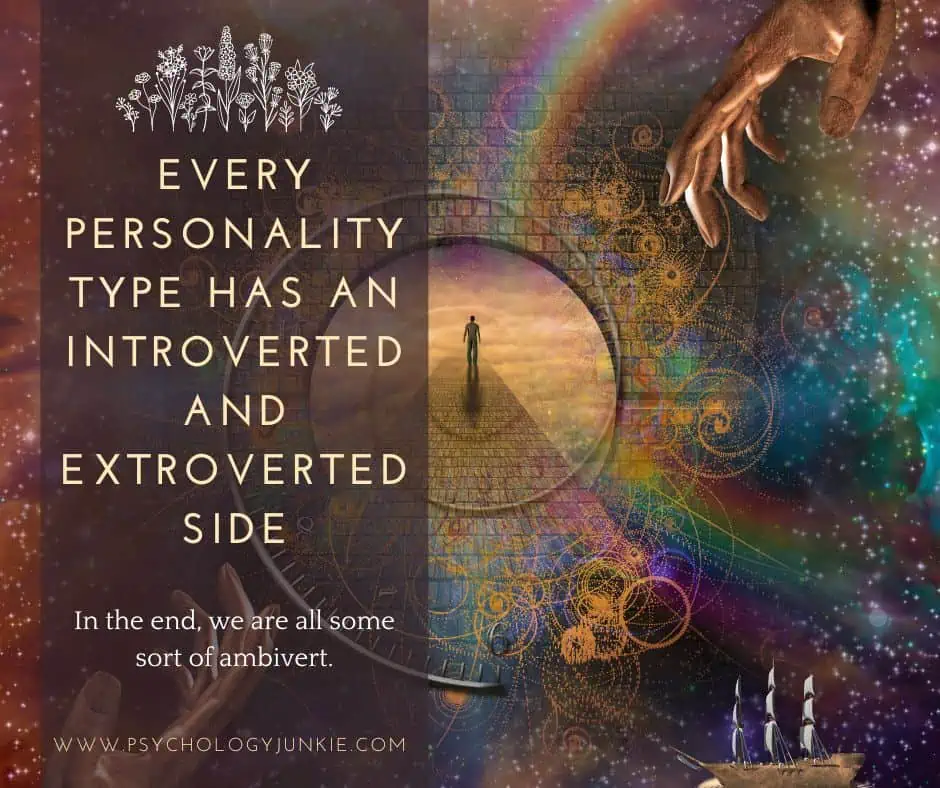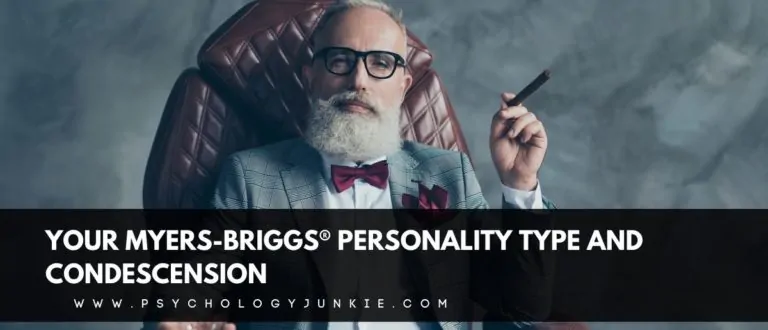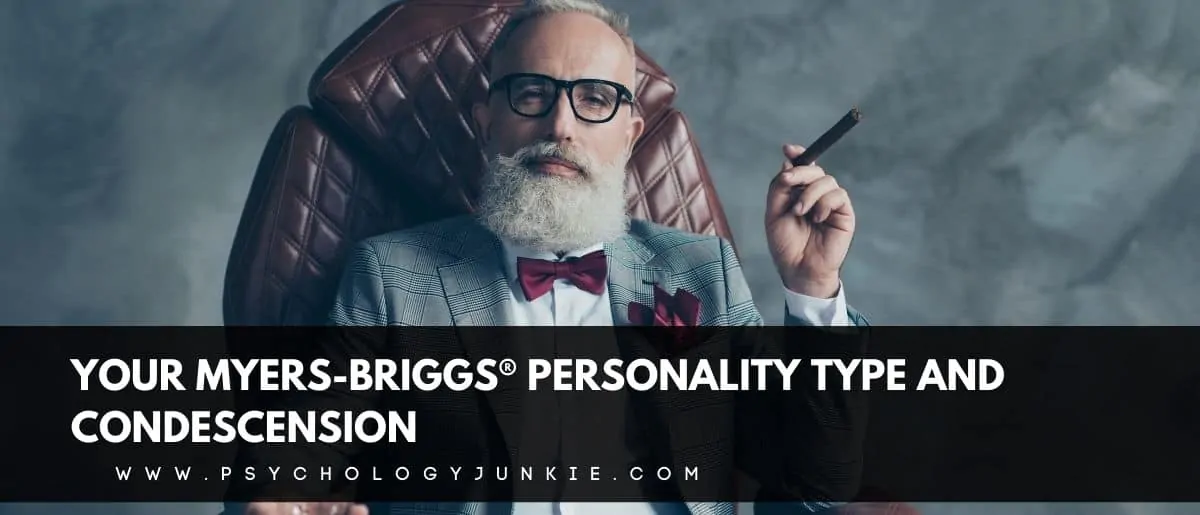The Introverted Side of Each Myers-Briggs® Personality Type
Have you ever wondered to yourself, “Am I an introvert, extrovert, or ambivert?” Many people feel that there is both an introverted and extroverted part of themselves and that pure introversion or pure extroversion doesn’t work for them.
Carl Jung himself said, “There is no such thing as a pure introvert or extrovert. Such a person would be in the lunatic asylum.”

Yet many people think they must be one or the other, with no room for fluctuation.
But is this what Myers-Briggs® theory teaches us?
Are We All Ambiverts?
The answer might surprise you! While yes, your Myers-Briggs® personality type will consist of an I or E to indicate whether you have a preference for Introversion (I) or Extroversion (E), it also leaves room for nuance.
Each of the 16 personality types has two introverted mental processes and two extroverted mental processes. They also prefer one of those processes above them all.
An INTJ, for example, is an introvert. This can be deduced by the I at the beginning of their four-letter type code. But they have the following four cognitive functions:
Dominant: Introverted Intuition
Auxiliary: Extroverted Thinking
Tertiary: Introverted Feeling
Inferior: Extraverted Sensing
As you can see, INTJs have two introverted processes (Intuition and Feeling) and two extroverted processes (Thinking and Sensing). They are, indeed, some kind of ambivert if we want to be technical about it. Yet because the dominant function is introverted, the INTJ will operate more naturally and frequently from an introverted place. They will consider the inner world before the outer world, and look inside their mind before assessing the outer situation. Yet at times, when they are interacting with the world around them, they will operate from a more extroverted place of Thinking and Sensing. During these times they may even look to others as being “extroverted.”
Of course, people are all unique and the way they show up in the world will vary depending on how they develop the different sides of themselves. Some INTJs avoid outer-world interaction excessively, and thus their extroverted functions are fairly undeveloped and immature—but this doesn’t mean they’re not there. Some INTJs are forced to interact with the external world to an excessive degree. Thus they may have less developed introverted functions than the average INTJ.
In today’s article we’re going to dive into the introverted side of each Myers-Briggs® personality type. We’ll explore how each of the 16 types, even the extroverted ones, have an introverted side, and what that looks like and feels like.
Let’s get started!
Not sure what your personality type is? Try out our most highly recommended personality questionnaires:
- You can take our free personality questionnaire here
- You can take Personality Hacker’s personality questionnaire.
- You can take the official Myers-Briggs Type Indicator® for $49.95
This article contains an affiliate link to a questionnaire on Personality Hacker. If you purchase one of their courses, I get a small kickback that I can use to pay for hosting and other demands of this site. I only recommend courses I love.
Table of contents
- Are We All Ambiverts?
- The Introverted Side of Each Myers-Briggs® Personality Type
- The ISFJ “Protector”
- The ISTJ “Detective”
- The INFJ “Mystic”
- The INTJ “Strategist”
- The ESFJ “Defender”
- The ESTJ “Captain”
- The ENFJ “Mentor”
- The ENTJ “Director”
- The INFP “Dreamer”
- The INTP Prodigy
- The ISFP Virtuoso
- The ISTP Vigilante
- The ENFP Visionary
- The ENTP Trailblazer
- The ESFP Champion
- The ESTP Daredevil
- What Are Your Thoughts?
The Introverted Side of Each Myers-Briggs® Personality Type

The ISFJ “Protector”
Introverted Functions: Introverted Sensation (Si) and Introverted Thinking (Ti)
Extroverted Function: Extraverted Feeling (Fe) and Extraverted Intuition (Ne)
When ISFJs are able to tap into their introverted side, they experience rich imagery from their past via detailed mental recollections. And they won’t just recall the images from their past, they’ll recall textures, scents, sounds, and even internal feelings they had.
Everyone has memory, to be sure. ISFJs aren’t the only ones who have rich memories stored in their minds. ISFJs, however, will pull from that memory more frequently than certain other types and use that memory as a trusted guide that leads them into the future.
ISFJs can quickly move from past to present, comparing and contrasting and reflecting. They may do this to see if a situation is comfortable for them; familiar and secure. Alternatively, they may do this to see if a situation is threatening to them; unfamiliar and unpredictable.
The introverted side of the ISFJ seeks out familiarity, routine, security, and stability. It also storehouses experiences and memories that can be grasped at any time for comfort or direction.
There’s also a logical, analytical side to the ISFJ. Protectors enjoy studying subjects of interest in depth, learning every detail, and understanding how various things work that they are interested in. The inner world of the ISFJ is one of rich memories and experiences, yes, but also one that is fairly logical and meticulous. While Protectors strive to create warm, empathetic connections with others, their inner world is often far more analytical than people realize.
Find Out More About ISFJs: A Look at the ISFJ Leader
The ISTJ “Detective”
Introverted Functions: Introverted Sensation (Si) and Introverted Feeling (Fi)
Extroverted Function: Extraverted Thinking (Te) and Extraverted Intuition (Ne)
When ISTJs are able to tap into their introverted side they become deeply in touch with the details of all the projects and plans that matter to them. Detectives like to have all their plans carefully laid out and all their “ducks in a row” so that they can relax and enjoy themselves when they’re done with work.
If ISTJs have work to do, then they focus on organizing their work and carefully prioritizing what should happen first, next, and so forth. They will be meticulous with details and keen on spotting anything that doesn’t seem right or fit with how things “should” be.” Often at the end of the day ISTJs will mentally map out their next day so they know what their routine will be. They will refresh their mind first thing in the morning with their daily “to-do” list.
If ISTJs are free from work then they enjoy quiet time to tinker with their hobbies, watch favorite movies, peruse a book they love, or simply reflect on their day in peace and quiet. They crave this undisturbed solitude to recharge and let their thoughts wander. During this time they may assess their values and whether they’ve lived up to them. Have they honored their moral code? Have they met their responsibilities and duties? ISTJs take matters of right and wrong very seriously and will often spend time analyzing whether they’ve lived in a way that they can feel proud of.
Like ISFJs, ISTJs also look to the past to guide them in the future. They have rich mental imagery that they rely on to comfort them, guide them, or keep them on track. For example, they may notice the smell of a wood-burning fire and be transported to a childhood memory of curling up with their childhood dog on Christmas Eve by a fire. At work they may encounter a difficult situation and be reminded of a similar one they faced in the past. This can help them make decisions about the current situation with confidence.
Find Out More About ISTJs: 7 Things ISTJs Experience in Childhood
The INFJ “Mystic”
Introverted Functions: Introverted Intuition (Ni) and Introverted Thinking (Ti)
Extroverted Functions: Extroverted Feeling (Fe) and Extroverted Sensing (Se)
The introverted side of the INFJs manifests in their need for deep, sustained reflection and contemplation to help them make sense of the world around them. Mystics crave solitude and quiet where they can turn off all the demands and distractions of the external world to focus on insights and patterns. During these moments they may think of metaphors, symbols, and insights that have come to them throughout the day or they may get flashes of insight that give them a sense of how things will unfold.
As dominant intuitives, INFJs are always trying to ascertain the “dance of the universe” and the hidden connections between all of its parts. Their passion for uncovering the deeper, underlying meanings behind things is what guides them in life, be it through studying philosophy or exploring spiritual paths.
INFJs often take solace in their own inner world where they can find comfort and strength during tough times. Often Mystics enjoy journaling practices, where they can get their deeper feelings out on paper in order to process them fully. They enjoy reading books that give them further insights on the human experience or studying subjects that help them understand abstract concepts better. Often Mystics are drawn to spirituality, psychology, or even science. Anything that can help them to have a richer understanding of the universe and the people in it.
While INFJs present a warm, gentle exterior, their inner world can be far more analytical than people realize. Like ISFJs, they have a tertiary mental process called Introverted Thinking. This thinking side spots logical inconsistencies, wonders how things work, and roots out biases. When healthy, INFJs are warm and gentle but also fairly rational and meticulous in their logic. When unhealthy, INFJs may avoid this side of themselves or use it in a warped or unreasonable way.
Find Out More About INFJs: 7 Things That INFJs Experience As Children
The INTJ “Strategist”
Introverted Functions: Introverted Intuition (Ni) and Introverted Feeling (Fi)
Extroverted Functions: Extroverted Thinking (Te) and Extroverted Sensing (Se)
The introverted side of the INTJ focuses on patterns, predictions, and insights. Strategists often have a clear vision in mind, be it to solve a problem or create something new that will make an impact on the world. To reach their goals they need periods of solitude to process and plan out their strategies. They are often drawn to quiet offices or libraries where they can muse and ponder. Being alone in nature revives them as well, and many INTJs enjoy solitary hikes or nature walks.
In their quiet moments, INTJs enjoy considering the nature of the universe. Driven more to deeper waters than shallow subjects, Strategists want to understand the profound and mysterious. They are often drawn to subjects such as philosophy and can spend hours debating and discussing the greater questions of life with those close to them.
Strategists believe in charting the course of their lives and are always looking ahead. In the quiet moments, they map out their futures and concoct detailed plans. Pruning out inefficient strategies and finding the best possible plan is something they spend a lot of energy doing.
While INTJs appear stoic and rational on the outside, they also have a deeply feeling inner core. Strategists have strong convictions and values that they hold dearly. While they may not wax poetic about all their feelings (the idea of doing so is likely to make them cringe), they do have intense feelings about causes and beliefs that matter to them on a personal level. Many people who get close to INTJs are surprised to find out that they are deeply sensitive underneath their tough outer shell.
Find Out More About INTJs: The Underrated Kindness of the INTJ Personality Type
The ESFJ “Defender”
Introverted Functions: Introverted Sensing (Si) and Introverted Thinking (Ti)
Extroverted Functions: Extroverted Feeling (Fe) and Extroverted Intuition (Ne)
ESFJs have an inner world filled with detailed memories, impressions, and experiences. These types love to recall and revisit their past, either through conversation with friends or in their own thoughts. They often reminisce about fond memories and can be deeply sentimental. Many Defenders are drawn to photography as a way of capturing and re-experiencing moments in time. Others enjoy journaling their experiences so they can revisit them later. In the quiet moments they love to reflect on their favorite memories and think of ways to re-visit those memories again through future experiences.
While Defenders are Feeling types, they can also be very analytical when they’re alone. Their introverted thinking side shows up in a desire to accurately understand and apply principles to their relationships. Often they have various interests that they research to the hilt. When they get time alone, it’s not unusual to find them poring over articles or how-to books on a subject they’ve recently picked up. Alternatively, they may piece apart their relationships to try to understand how they all fit together in a logical sense.
Socially, ESFJs feel a deep sense of responsibility towards others. They are often driven to make sure everyone around them is feeling happy and secure. This drive can sometimes be so strong that it causes them to neglect or ignore their own inner rational side in favor of people pleasing and making sure everyone around them is comfortable. When ESFJs nurture their introverted side as well as their extroverted side they are able to make wiser and more logical decisions because they have more balance and inner harmony.
Find Out More About ESFJs: 7 Things That ESFJs Experience as Children
The ESTJ “Captain”
Introverted Functions: Introverted Sensing (Si) and Introverted Feeling (Fi)
Extroverted Functions: Extroverted Thinking (Te) and Extroverted Intuition (Ne)
While ESTJs can look very commanding and sociable on the outside, they too have an introverted side that is more nuanced than people realize. As Sensing-Judgers, they have a vast world of impressions, memories, and experiences that they like to revisit during their time alone. They enjoy commemorating routines, traditions, and life events – cementing them in their personal history through repetition. Many ESTJs enjoy reflecting on their favorite memories or on past lessons they’ve learned during their times alone.
ESTJs also enjoy taking time to notice the finer details in life. When they’re alone they may enjoy taking walks in nature and noticing every detail of the plant life or the clouds in the sky. They can also be quite creative when on their own, and enjoy activities like writing, crafting, or even playing music that express their inner feelings more intimately than they would around others.
In addition to being reflective ESTJs also have a deeply value-driven side. Their introverted Feeling side lends to a strong sense of personal integrity and an ethical backbone that they take seriously. ESTJs are driven to do what is right and may struggle with making decisions that don’t feel aligned with their values even if there would be tangible advantages to doing so. Knowing this about themselves, ESTJs can make a point of finding out what matters most in any given situation before taking action. This helps them stay true to their values and make decisions that they can be proud of.
When ESTJs aren’t giving enough time to their introverted side, they can be rash and make decisions they regret later. The more unhealthy an ESTJ is, the more out of touch they will be with their values – or they may push their values onto other people, considering anyone who doesn’t agree as “bad” or “wrong.” Embracing the introverted and extroverted sides of the self enables ESTJs to experience more inner and outer harmony.
Find Out More About ESTJs: A Look at the ESTJ Leader
The ENFJ “Mentor”
Introverted Functions: Introverted Intuition (Ni) and Introverted Thinking (Ti)
Extroverted Functions: Extroverted Feeling (Fe) and Extroverted Sensing (Se)
ENFJs are naturally warm and compassionate people, eager to help others and make a difference in the world. They have a natural drive towards understanding the deeper meaning of things, to peer “behind the curtain” and make sense of the universe. In their quiet moments, ENFJs pick up on patterns, map out predictions, and look for insights that will guide them in the future. While SJ types often recall past experiences in their alone time, ENFJs are more likely to anticipate future experiences in their alone time.
ENFJs also enjoy exploring their creative side when they are alone. They have an innate appreciation for beauty and aesthetics, and have a knack for creating something unique that expresses their own unique perspective on life. This is a great way for ENFJs to stay connected to their inner world, and can be an amazing outlet for them in times of stress.
Unfortunately, many ENFJs forget their introverted side in the face of taking care of others. They may neglect their own needs or overlook warning signs that something isn’t quite right until it’s too late. ENFJs should make a point of regularly taking time for themselves to reflect on their feelings and insights, lest they get overwhelmed and burnt out from caring for everyone else.
Another side of the ENFJ that is rarely talked about is their thinking side. ENFJs enjoy piecing apart concepts, ideas, and theories to understand how they work. They enjoy learning about people to figure out all their various components and how they all fit together. While ENFJs exude warmth and empathy on the outside, on the inside they can be deeply analytical – deconstructing people and putting them back together in their mind in order to understand how they function.
Find Out More About ENFJs: A Look Inside the ENFJ Mind
The ENTJ “Director”
Introverted Functions: Introverted Intuition (Ni) and Introverted Feeling (Fi)
Extroverted Functions: Extroverted Thinking (Te) and Extroverted Sensing (Se)
ENTJs are known for their strategic minds and strong drive for success. They tend to be organized, analytical, and ambitious – but they also have a more sensitive, inner core as well.
In their private moments, ENTJs use the power of introversion to take a step back and examine their goals from a different perspective. As intuitives they enjoy focusing on patterns, trends, insights, and concepts. They can be just as fascinated by the ever-changing world of business as the worlds of philosophy or spirituality. When they’re alone they enjoy playing with a mental sandbox of ideas, looking for connections that will prove useful in the future.
ENTJs also spend a lot of time exploring their inner world when alone, though this isn’t something they often talk about. Through introverted feeling (Fi), they can tune into their own values and ethics. They often have strong convictions and when they’re alone they will analyze their day to see whether or not they’ve aligned themselves with what they felt was right. In their quiet moments, ENTJs are often more sensitive and compassionate than they are usually given credit for.
The ENTJ’s introverted side is rarely seen in the public sphere, where Directors often come across as blunt and assertive. People often make assumptions about them, thinking they are all business and no heart. This is a mistake, however – the heart is often the foundation that propels ENTJs into action. They often use their ambition and strategic prowess to help a cause that matters to them indirectly. Perhaps they donate a large part of their profit to charity or help plan out initiatives for non-profits. As with all personality types, there is a lot more than meets the eye with ENTJs.
Find Out More About ENTJs: 24 Signs That You’re an ENTJ, the Director Personality Type
The INFP “Dreamer”
Introverted Functions: Introverted Feeling (Fi) and Introverted Sensing (Si)
Extroverted Functions: Extroverted Intuition (Ne) and Extroverted Thinking (Te)
INFPs, often referred to as Dreamers, are known for their creativity and unique perspective. They tend to take life at a slower pace, taking time to process whatever is happening and explore the richness of their internal world. INFPs embrace being introverted, delighting in spending time alone to contemplate, imagine, and create.
When INFPs are alone, they often use their introverted feeling (Fi) to explore their personal values and motivations. They have a deep appreciation for authenticity and strive towards living with integrity. Living a life that matters and aligns with their values is of the utmost importance to INFPs. But they’re in no rush; they take their time to understand life rather than race through it.
INFPs also enjoy using their extroverted intuition (Ne) to look at the world from different angles, considering possibilities that others may not explore. They can be consumed by their imagination – seeing an array of unique perspectives that inspire them to create in a variety of forms. During their alone times, INFPs enjoy harnessing their imagination to create something new or explore a different avenue than the one they’re accustomed to.
Dreamers also have a sentimental side that is rich with nuanced memories, reflections, and impressions. Through their introverted sensing (Si) they often have a wealth of experiences that have left an impression on them. They may take personal time to reminisce or reflect, connecting with their past in order to make sense of the present. Often they have special routines or rituals that make them feel comforted and safe. For some these rituals can look like little daily routines, for others they can be comforting songs they listen to, movies they watch, or books they re-read to find a sense of security and peace.
The INFP’s introverted side is often hidden behind a veil of playfulness and whimsy. People are often surprised to find out how complex and introspective INFPs really are – with a deep appreciation for the unique in both themselves and others.
Find Out More About INFPs: A Look at the INFP Leader
The INTP Prodigy
Introverted Functions: Introverted Thinking (Ti) and Introverted Sensing (Si)
Extroverted Functions: Extroverted Intuition (Ne) and Extroverted Feeling (Fe)
INTPs have an incessant need to figure out how things work. This can manifest in many different forms, ranging from engineering to philosophy. They enjoy exploring the unknown and often take great pleasure in developing new theories or solving complex problems.
INTPs need alone time to reflect and work on their ideas, often without the expectation of immediate feedback or recognition. This is due in part to their primary function – introverted thinking (Ti). INTPs thrive when they can explore complex theoretical problems and find patterns to help them reach a conclusion. But they hate to be rushed or held up to a lot of external demands and pressures.
While exploring big concepts may be fun, INTPs also like to focus on the details. This is thanks to their introverted sensing (Si), which looks for patterns and connections in the past. They often need time to review old information and data, connecting it with what they already know in order to help them come up with creative solutions. Like most types with Introverted Sensing, INTPs also enjoy comfortable routines, rituals, and habits. They often have favorite movies, songs, books, or TV shows that they revisit to help them feel secure.
Prodigies have a deep admiration for the extraordinary and peculiar. They love to invest their time in exploring various ideas, from philosophical notions to theoretical musings. INTPs often also aptitude for creativity that is powered by their passion of gaining wisdom – like fixing up programming or devising innovative inventions. When they honor their introversion, INTPs are capable of delving into their imagination, finding answers and insights that are often surprising and original.
Find Out More About INTPs: A Look at the INTP Leader
The ISFP Virtuoso
Introverted Functions: Introverted Feeling (Fi) and Introverted Intuition (Ni)
Extroverted Functions: Extroverted Sensing (Se) and Extroverted Thinking (Te)
ISFPs appear quiet and mysterious, there’s a world behind their eyes that is often hidden from view. They are deeply sensitive and have an affinity for creative expression and beauty. Getting plenty of time alone is crucial for this type, but they also need time to explore the world around them in a hands-on way. They enjoy observing beauty in nature, people, or in artwork. Many enjoy creative pursuits such as painting, writing, photography, and music. Many times their rooms are filled with creative projects or trinkets that have a personal meaning to them.
ISFPs are naturally introspective, searching to understand themselves and the world around them. They rely heavily on their Introverted Feeling (Fi) to stay in touch with their emotions, forming a deep connection with what they value most in life. As a result, ISFPs have strong convictions and can be very decisive when it comes to standing up for what they believe in.
ISFPs are also deeply intuitive individuals, using their Introverted Intuition (Ni) to uncover patterns and meanings that may not be apparent on the surface. They can often sense things about people and situations that others may not recognize. However, because they are so quiet, it can be hard for others to recognize the depth of their insights.
Ultimately, ISFPs need time and space to reflect on things that are important to them while simultaneously engaging in activities they find meaningful. They seek a balance between exploring the physical world around them and going deep within themselves. When they find harmony in these two areas, they can achieve a great level of personal growth and insight.
Find Out More About ISFPs: How ISFPs Say “I Love You”
The ISTP Vigilante
Introverted Functions: Introverted Thinking (Ti) and Introverted Intuition (Ni)
Extroverted Functions: Extroverted Sensing (Se) and Extroverted Feeling (Fe)
ISTPs are independent and analytical individuals who often enjoy tinkering with machines, instruments, and tools. They have an innate curiosity that drives them to explore the physical world around them, taking things apart and figuring out how they work. When left to their own devices, ISTPs enjoy delving into topics that interest them, tinkering with physical objects, or playing games (video or board games) that let them troubleshoot and think fast.
ISTPs tend to see things logically and work to develop personal principles about how they will live their lives. They hate anything that doesn’t make sense, and they develop their own rules about life that are independent of what others may think. When they hear a rule, they’ll think “Does this make sense in the present moment?” and if it doesn’t, they may see it as pointless. This can give them the reputation of being rebellious.
ISTPs enjoy exploring the world on their own terms and tend to be solitary individuals who need plenty of time alone to recharge. They thrive when they are allowed to think independently and come up with creative solutions. When they take time away from the hustle and bustle of life, ISTPs can truly tap into their powerful combination of functions and become some of the most innovative problem solvers around.
Find Out More About ISTPs: 24 Signs That You’re an ISTP, the Vigilante Personality Type
The ENFP Visionary
Introverted Functions: Introverted Feeling (Fi) and Introverted Sensing (Si)
Extroverted Functions: Extroverted Intuition (Ne) and Extroverted Thinking (Te)
ENFPs are fun-loving and creative individuals who enjoy thinking outside the box and dreaming up possibilities. They are passionate about life and enjoy moments filled with adventure and new discoveries. To constantly be learning, experimenting, and dreaming is something that drives them.
While ENFPs may seem very extroverted on the outside, they also have a deeper and more private introverted side. In order to explore their inner world, ENFPs need time alone to reflect on what matters to them and ponder the possibilities of life. They often find themselves drawn to creative or artistic pursuits that allow them to express themselves in a unique way.
In their quiet moments, ENFPs reflect on their values, what matters to them, and how their emotions are affecting them. They have a strong sense of conviction and a desire to live life on their own terms. They are often more private emotionally than people realize, processing their emotions better alone than out-loud.
Visionaries also have a sentimental side that can show up in their alone time. They may reflect on cherished memories, revisit a favorite pastime, or collect trinkets that have sentimental value. When alone, ENFPs often rehash their day and look for lessons they can learn from it. They also dream about new possibilities for the future and can usually create dozens of potential alternate paths in their minds. This quiet time for imagining and reflecting is crucial for their well-being.
Find Out More About ENFPs: A Look at the ENFP Leader
The ENTP Trailblazer
Introverted Functions: Introverted Thinking (Ti) and Introverted Sensing (Si)
Extroverted Functions: Extroverted Intuition (Ne) and Extroverted Feeling (Fe)
ENTPs are brilliant thinkers and have a unique view of the world. They see the potential in everything and strive to be on the cutting edge of innovation. They enjoy challenging themselves to think outside the box and come up with creative solutions to problems.
These Trailblazers also have an introspective side that few people get to see. When given the time and space to do so, ENTPs enjoy considering the ins and outs of many different concepts and ideas. Their minds are constantly posing questions and looking for answers.
ENTPs may retreat to their own thoughts when they are feeling overwhelmed by the outside world, or just need some space to process something. They enjoy digging deep into their ideas, exploring the different possibilities and consequences of a situation. Naturally gifted at troubleshooting, ENTPs use their alone time to process the angles of a situation and think about how it can be resolved. They are skilled at weighing leverage points, finding inconsistencies in logic, or dreaming up new ways of looking at things.
ENTPs also find solace in nature, allowing themselves to disconnect from the chaos of society and connect with something greater than themselves. This allows them to recharge and reconnect with the physical world and feel more grounded. Many ENTPs have favorite places they like to visit again and again that give them a sense of comfort and familiarity. Because ENTPs are so often pulled in many different directions, it’s important for them to have places they can go to feel grounded, secure, and in touch with what’s real.
Find Out More About ENTPs: 24 Signs That You’re an ENTP, the Trailblazer Personality Type
The ESFP Champion
Introverted Functions: Introverted Feeling (Fi) and Introverted Intuition (Ni)
Extroverted Functions: Extroverted Sensing (Se) and Extroverted Thinking (Te)
ESFPs love adventure and being in the moment. They are deeply curious and thrive when they can explore their environment and learn from experience. They’ve been called “The Entertainers” in many type circles, and it’s not hard to see why. The funniest people I’ve ever known have been ESFPs and ENFPs; they say what other people are thinking but are too uptight to admit.
However, beneath the surface of their outgoing personalities lies a side of ESFPs that few people get to witness. When given the chance, ESFPs take a step back from their day-to-day lives and reflect on what is important to them. They focus on the things that stir their emotions and give them a sense of meaning and fulfillment.
In their alone time, ESFPs draw inward. What causes stir their hearts? Are they living in alignment with what they really feel is right? What are their deeper instincts and emotions telling them?
Many ESFPs during these times analyze their interactions with others and attempt to find deeper meaning in conversations they had or decisions they made. While ESFPs often act on instinct and gut feeling, this introverted side of them allows them to take a step back, think through their decisions, and reflect on the impact that their choices may have.
I’ve talked to several ESFPs who find themselves analyzing their relationships and choices and feeling guilty at night during this process, too. Sometimes the quiet can bring up darker feelings, guilt, or shame that isn’t warranted. If you find your mind turning to darker places when you’re alone, practice some deep breathing techniques or visualization exercises to find calm. Look for the nugget of truth in the insights you find, but discard anything that is telling you that you’re “not enough,” or you’ve failed in some way. That inner core of you can be deeply insightful, but at times anxiety can step into the mix and make you feel like you’re never quite living up to your values “enough.”
So while the outside world might see an ESFP who is enthusiastic, fun-loving, and talkative, on the inside there’s a deeper, more sensitive inner core. Many ESFPs develop insights about people and situations during these times. And often these insights guide make them deeply perceptive of others’ motivations, intentions, and hidden feelings.
ESFPs also appreciate occasional moments of peace and quiet when they can be creative in solitude. They often enjoy artistic pursuits such as painting, photography, or even dancing! Being able to tap into the artistic and expressive side of themselves allows them to connect with their emotions and feel grounded in who they are. ESFPs often find solace in nature, allowing them to disconnect from the noise of society and reconnect with the beauty of the natural world.
Find Out More About ESFPs: What It Means to be an ESFP Personality Type
The ESTP Daredevil
Introverted Functions: Introverted Thinking (Ti) and Introverted Intuition (Ni)
Extroverted Functions: Extroverted Sensing (Se) and Extroverted Feeling (Fe)
ESTPs are outgoing and energetic individuals who thrive in fast-paced environments. They are natural problem solvers and work best with their hands – they love to tinker, experiment, and find practical solutions to problems.
However, ESTPs also have an introverted side that few know about. In moments of stillness and quiet, ESTPs often take the time to reflect on their lives and prioritize what is truly important. They use their alone time to analyze their decisions, weigh pros and cons, or research a topic that interests them. Many enjoy unwinding by playing video games or doing a solitary recreational activity like kayaking or hiking.
ESTPs also enjoy getting in touch with their creative side. Whether they’re channeling their entrepreneurial instincts into a new business endeavor or creating a podcast, they enjoy finding new ways to express themselves and explore their interests.
Finally, ESTPs often find peace in nature. They take pleasure in the beauty of the world around them – from a stunning sunset to the majesty of a mountain range. Being surrounded by natural beauty allows ESTPs to disconnect from the chaos of everyday life and reconnect with what’s truly important.
Find Out More About ESTPs: 24 Signs That You’re an ESTP, the Daredevil Personality Type
What Are Your Thoughts?
Did you enjoy this article? How do you experience the introverted side of your personality? Share your thoughts with other readers in the comments!
Find out more about your personality type in our eBooks, Discovering You: Unlocking the Power of Personality Type, The INFJ – Understanding the Mystic, The INTJ – Understanding the Strategist, and The INFP – Understanding the Dreamer. You can also connect with me via Facebook, Instagram, or Twitter!














So next time we’ll go to the extraverted side…
I think how introverted or extroverted someone is depends on the percentage they get when they take the quizzes. I score 95% introverted, so I’m firmly an introvert. Where I’m more in the middle is in T and F, so both INTJ and INFJ sound accurate of me. I disagree with the cognitive functions portion of this theory though. I think my functions would go in this order: Fi, ti, si, fe, ne, te, ni, se. As you can see, I’m heavily the introverted functions. I know the theory says this combination is not possible, but that’s why I disagree with the theory.
Hello, Susan! Sou brasileira e estou adorando seu site, sempre procurei sites para saber mais sobre minha personalidade Istj, porém não é qualquer um que é de fácil entendimento e didático como o seu, muito obrigada! Seu site é incrível!
I totally lined up with ENFP while over the years I questioned if I’m an ENTP. Because in so many of your articles both match up with me. However in this article the ENTP didn’t sound like me at all until the very last paragraph about finding solice in nature and that whole paragraph was EXACTLY ME!
So I’m curious does that paragraph fit an ENFP? Because I’m not any of that other part of the ENTP description. Please help me understand. tia
My ex is also an ENTP who sometimes fits the description of ENFP. But for him where he fits ENFP is when it comes to romantic relationships, and he doesn’t have much interest in nature at all. In my opinion, T types are more analytical/logical while F types are more concerned with doing what other people want or worrying what other people will think, therefore F types are more tactful, sensitive, compassionate, soft hearted, comforting, etc. For example, T types will tell the blunt truth while F types will soften the truth with a lie to be nice or polite. But if you score near the 50% mark on T or F, then you’ll be in the middle of the spectrum, and both T and F will be true of you. I usually score 60% T, so I’m near F, and the INFJ description describes me about equally well as INTJ.
(Corrected comment) Thank you! These articles help me understand how my partner and I function in different ways. Being an ENFJ I often try to emulate practices my partner (ISTJ) does to reflect, recreate, and function well, but get burnt out quickly!
Thank you for this posting. I have known I was an ISFJ or an ISTJ but was having trouble figuring out the difference between. This helped me see the difference.
Myers-Briggs personality “types” are flawed, because each aspect assumes a binary condition. Personality doesn’t work like that. Personality characteristics exist on a spectrum, not absolute binaries. No one is absolutely an introvert or extrovert; most people fall somewhere in-between. By creating “types”, the M-B is just too simple and too unreliable. There are better personality assessments. I don’t know anyone in psychology that gives it any credence anymore.